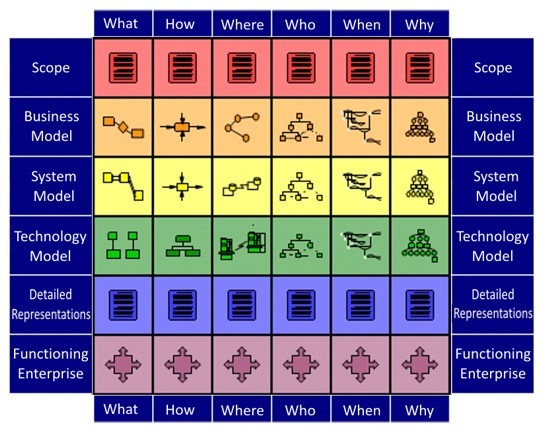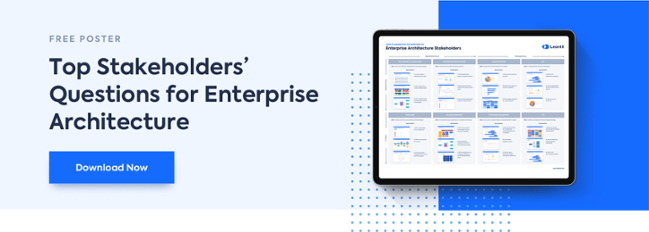
The birth of Enterprise Architecture
In the 1980s, John Zachman wrote “A Framework for Information Systems Architecture,” and from there, the ideas around Enterprise Architecture were born. Zachman pointed out that with the increasing size and complexity of the implementations of information systems, it would be beneficial to construct architecture for defining and controlling the interfaces and the integration of all of the components of the system.
At its root, Enterprise Architecture is nothing more than a detailed plan for how IT will be managed in the enterprise. The plans - often illustrated through models, graphs, and charts, are detailed enough to ensure interoperability and backed up by supporting policies. Nearly 40 years later, the underlying basis still stands - but Enterprise Architecture has taken a different path to achieve the same outcome.
The Zachman Framework for Enterprise Architecture
Zachman's original framework is a table with columns that relate to the:
- what (data),
- how (function),
- where (network),
- who (people),
- when (time or schedule)
- why (motivation or strategy)
Aspects of the architecture and rows that go down the scope continuum:
- Context (partners),
- Business Model (owners),
- System Model (designer),
- Technology Model (builder)
- Detailed Representations (subcontractor)

Image: The Zachman framework. (Source)
How to read the Zachman framework:
1. Pick a square from the Zachman framework. For example, ‘Process Specification.’
2. Ask yourself “What plans, policies and procedures does my organization have in place to make sure we do Process Specification consistently and in accordance with best practice?"
Innovation inspires the evolution of Enterprise Architecture
As a relatively young discipline, Enterprise Architecture has come a long way. Interest levels continue to be high, as demonstrated by the Harvey Nash/KPMG 2017 CIO Survey. Enterprise Architecture has become the fastest-growing, in-demand skill set in technology, up 26% from the last year’s report.
Enterprise Architecture has evolved from a supporting IT role into a dynamic, innovative thought-leading source of direction. Through collaboration, mindset change, and usage of specialized tools, Enterprise Architects are poised to deliver significant value to their companies by cutting cost and complexity while aligning IT concerns, technology tools, and strategic business goals.
Close collaboration with stakeholders
Enterprise Architects once lived in an Ivory tower, creating exhaustive models and plans, and subsequently relaying them to their teams. We now know that close collaboration and visibility is a key factor in the practice of Enterprise Architecture. Getting stakeholders more involved in the EA makes its purpose and value far more clear. Once EAs are easily communicating with and solving the issues of various stakeholders, their worth is more realized in the organization.
Stakeholders are looking for answers from Enterprise Architects. A Business Process Manager might ask, "Which applications support my process?" A CTO could ask, "What is our technology roadmap? A Developer might want to know, "Which microservices do we use?" Enterprise Architects should be able to answer all of these questions.
Agility
An agile Enterprise Architecture reduces time to markets and ensures efficiency. Ditching the lengthy modeling mindset, and co-opting a “just enough” or "lean:" architecture policy enables an agile landscape. Failure to implement a lean Enterprise Architecture plays a huge part in an organization’s failings in staying agile. It takes the EAs focus away from the businesses future-state, and instead, bogs them down with the past and current. By focussing on a lean, collaborative approach, companies can base their digital transformation on a solid foundation.
Specialized Tools
As the Enterprise Architecture discipline grows, organizations would benefit from using a specialized tool to achieve the key Enterprise Architecture views. Many organizations choose to use “self-made” Enterprise Architecture tools; including Visio, Powerpoint, and Microsoft Excel to keep track of their Enterprise Architecture endeavors for various reasons: cost, ease of onboarding, familiarity, or simple ignorance of specialized tools on the market. While it may be tempting to start out with what appears to be less costly, these solutions end up costing companies much more in the long run.
Specialized Enterprise Architecture tools offer many benefits that free tools do not:
- Modeling complexity
- Collaboration
- Visualizations
- Data quality and integrity
- Ease of use
- Integrations
- Compliance demonstration
- Best practice guidelines
- Scalability
Mindset change:
With the pace of business quickening at a rapid rate, old EA mentalities are forced into obsolescence. Successful EAs of tomorrow must acquire five integral traits to guide their company to success. Implementing these traits will enable the company to scale up and quickly meet the speed and demands brought forth by digital transformation.
EAs with tunnel vision on long-term plans and conceptual processes are no longer valuable to their teams. EAs of the future architect the organization’s landscape as a problem-solving tool to drive digital transformation. To stay competitive, EAs of Tomorrow will keep one eye on the model while swiftly guiding the company towards the future through predicting market trends, researching current trends on the radar, evangelizing opportunities on the horizon, and integrating new technologies.
Out of office collaboration:
Now that we realize that Enterprise Architecture is collaborative, be sure to keep Enterprise Architecture events on your radar to stay connected and learn from various Enterprise Architects from around the world. As the discipline grows, LeanIX is dedicated to curating an EA community around the world.
The evolution of Enterprise Architecture is exciting. We've gone from a complex mapping and modeling exercise to directly increase the confidence level of executives in decision making. To stay at the forefront of the evolution of Enterprise Architecture, join our mailing list below for quick tips, industry updates, and humorous Enterprise Architecture comics.
![The Enterprise Architect of Tomorrow [White Paper]: Practical insights on how to become data-driven, agile-minded, and forward thinking. »](https://no-cache.hubspot.com/cta/default/2570476/49fd1c31-67ad-464a-9aae-3ed5e866a24e.png)

![Digital Transformation: A Case for Lean Enterprise Architecture Management [White Paper]:Practical insights into how to establish and nurture a modern Enterprise Architecture Management. »](https://no-cache.hubspot.com/cta/default/2570476/eb7b0810-d1b7-4840-8793-de384353e6dc.png)


/EN/Reports/Thumbnail-Obsolescence-Gartner.png?width=140&height=100&name=Thumbnail-Obsolescence-Gartner.png)
/EN/White-Paper/EN-IDC-Inforbrief-Application-Rationalization-Portfolio-Management-Thumbnail_v2.png?width=140&height=99&name=EN-IDC-Inforbrief-Application-Rationalization-Portfolio-Management-Thumbnail_v2.png)

